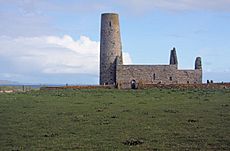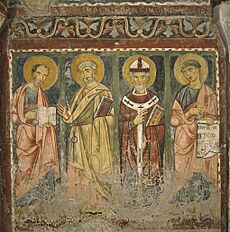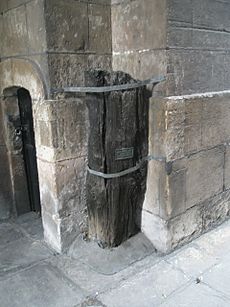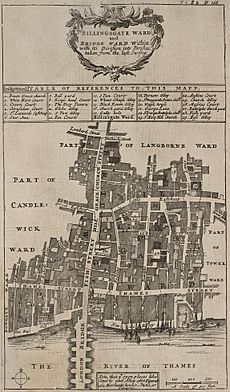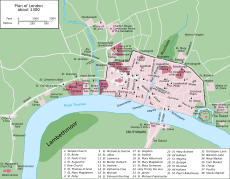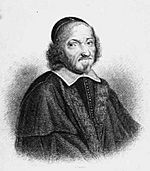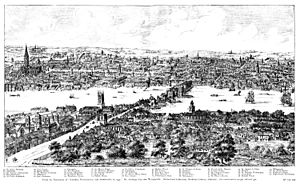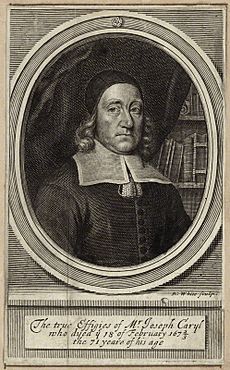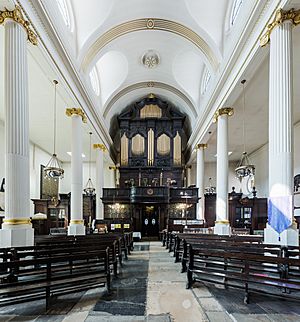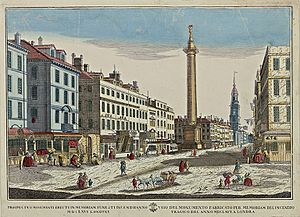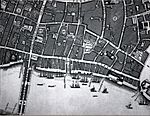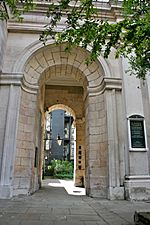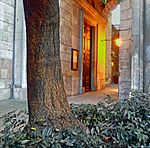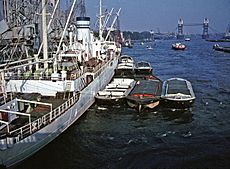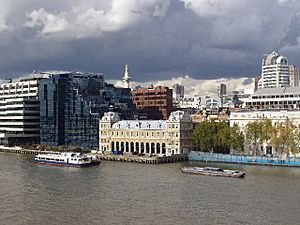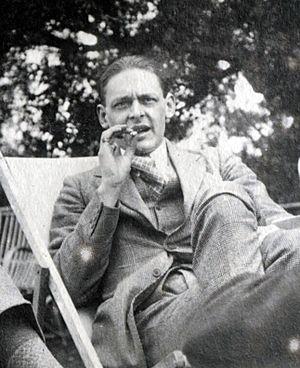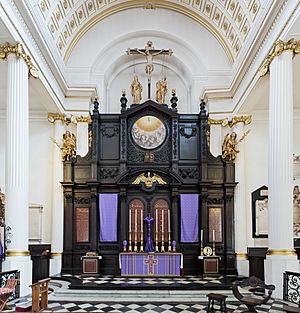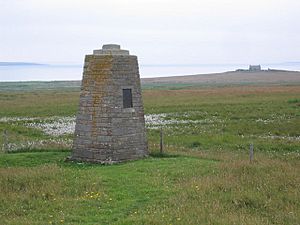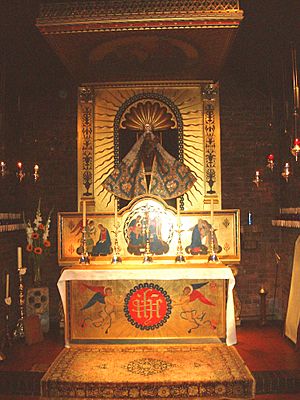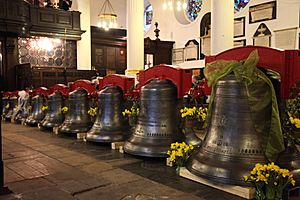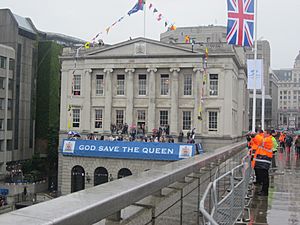St Magnus the Martyr facts for kids
Quick facts for kids St Magnus the Martyr |
|
|---|---|
| Parish and Pilgrimage Church of St Magnus the Martyr | |
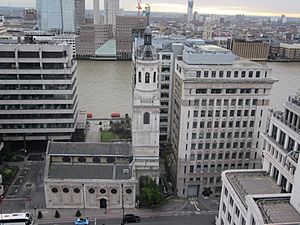
St Magnus the Martyr
|
|
| Location | London, EC3 |
| Country | England |
| Denomination | Church of England |
| Previous denomination | Catholic Church |
| Churchmanship | Traditional Catholic |
| Website | stmagnusmartyr.org.uk |
| Architecture | |
| Heritage designation | Grade I listed building |
| Architect(s) | Christopher Wren |
| Style | Baroque |
| Administration | |
| Diocese | London |
St Magnus the Martyr, London Bridge is a Church of England church in the City of London. It stands on Lower Thames Street, very close to The Monument. This church is part of the Diocese of London and is a Grade I listed building, meaning it's a very important historical structure. The main priest, called the Rector, has a special title: "Cardinal Rector." This is a unique title in the Church of England.
St Magnus is located where the old London Bridge used to connect the City to Southwark. Over time, its parish joined with other nearby parishes. The church is also connected to important London groups called Fishmongers and Plumbers. It is also twinned with the Church of the Resurrection in New York City. Many famous writers have mentioned St Magnus. Charles Dickens wrote about its spire in Oliver Twist, and T. S. Eliot praised its beautiful inside in his poem The Waste Land. Eliot even called it "one of the finest among Wren's interiors."
Contents
- Who is Saint Magnus?
- Church History
- Early Days: 11th and 12th Centuries
- Stone Bridge and Saint Thomas Becket's Chapel
- 15th and 16th Centuries: Before and After the Reformation
- 17th Century: Fire and Rebuilding
- Last Years of Old London Bridge
- New London Bridge and Changes
- Late 19th and Early 20th Centuries
- Between the Wars: Father Fynes-Clinton
- World War II to Today
- Inside the Church
- Bells
- Connections to London Groups
- See also
Who is Saint Magnus?
The church is named after a saint called Magnus, but there's a bit of a mystery about which one! Today, it's dedicated to Magnus Erlendsson, Earl of Orkney, who died around 1116 or 1117.
Magnus of Orkney was killed on the island of Egilsay during a power struggle. He was known for being very religious and gentle. He became a saint in 1136. His nephew, St Ronald, started building St Magnus Cathedral in Kirkwall in 1137.
For a long time, people thought the London church was named after a different St Magnus. It wasn't until the 18th century that the idea of it being dedicated to Magnus of Orkney came up. In the mid-19th century, a Danish archaeologist, Professor Jens Jacob Asmussen Worsaae, strongly suggested the link to Magnus of Orkney. This idea became popular, especially after Magnus of Orkney's relics were found in 1919. The Bishop of London officially confirmed the dedication to St Magnus of Orkney in 1926. In 2016, the church celebrated the 900th anniversary of St Magnus's death.
However, many experts now think the church was originally dedicated to Magnus of Anagni. He was a bishop from Italy in the 2nd century who was killed for his faith. His feast day was on August 19th. This saint was well-known in England before the Norman Conquest. Several monasteries claimed to have parts of his body as relics. It's thought that the church's original dedication was to this earlier St Magnus.
Church History
Early Days: 11th and 12th Centuries
While there was a Christian community in Londinium (ancient London), there's no proof that any medieval churches in the City of London were built on Roman foundations. The area around London Bridge was empty for a long time after the Romans left.
When Alfred the Great rebuilt London in 886, new ports were created. A wooden bridge was in place by the early 11th century, which helped the area grow with traders. The waterfront became very busy. St Magnus was built south of Thames Street in the 11th century to serve the people living near the bridge. A piece of wood from the old Roman riverside wall, dating to about AD 75, was found during an excavation in 1931 and can now be seen at the base of the church tower.
The church was supposedly given to Westminster Abbey by William I in 1067, though this document might be a later copy. There's another record of the church from 1128–33. In the late 12th century, there was a disagreement over who controlled the church, but it was settled, and control was shared.
Stone Bridge and Saint Thomas Becket's Chapel
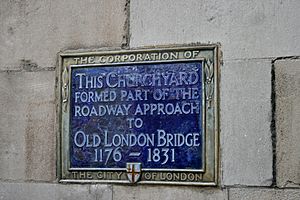
For centuries, London had wooden bridges. But in 1209, a stone bridge was finished. This bridge was built by a priest named Peter of Colechurch. Building bridges was seen as a very religious act back then.
Until 1831, the main road into London from the south went right past St Magnus. The bridge also had a chapel dedicated to St Thomas Becket. This chapel was for pilgrims traveling to Canterbury Cathedral. The chapel and most of the bridge were in St Magnus's parish. The church and chapel had a disagreement about money from pilgrims, which was later resolved. After the Reformation, the chapel became a house and then a warehouse.
The church itself became more important. In 1234, land was given to make the church bigger. In 1238, a thief ran to St Magnus for safety, which was allowed by law at the time. The church was said to be worth £15 a year in 1276.
In 1274, when King Edward I returned from the Holy Land, red and white wine flowed in the streets to celebrate. This happened on August 19th, which is St Magnus's feast day. In 1293, the fishmongers of London had a big parade to celebrate a victory against the Scots, and a knight dressed as St Magnus led the way.
An important religious group, the Confraternity de Salve Regina, was founded by 1343. Its members decided to join with another group to help restore and enlarge St Magnus church.
Henry Yevele, a famous builder who worked on Westminster Hall and Canterbury Cathedral, was a member of St Magnus. He rebuilt the chapel on London Bridge and was buried at St Magnus in 1400. Geoffrey Chaucer, the famous writer of The Canterbury Tales, lived near the bridge. His book mentions groups of tradesmen who might have belonged to guilds like the one at St Magnus.
15th and 16th Centuries: Before and After the Reformation
In 1413, money was given to build a new south aisle for the church. Land was also donated to create a cloister, which was mainly used as a graveyard.
St Magnus Corner, at the north end of London Bridge, was a busy meeting spot in medieval London. Important announcements were made there, and wrongdoers were punished. Because it was close to the River Thames, bishops often chose it for meetings of clergy.
The church had a group of singing children from the 1470s to the 1550s. In the mid-16th century, the old church looked similar to the present-day St Giles-without-Cripplegate.
Myles Coverdale, who helped translate the Bible into English, was Rector of St Magnus from 1564 to 1566. He was buried in another church, but his remains were moved to St Magnus in 1840.
In 1559, the church's rood (a large cross) and other religious items were destroyed due to strong Protestant feelings. In 1562, the churchwardens were told to break up all the altar stones. Coverdale's resignation from St Magnus in 1566 might have been linked to these changes.
17th Century: Fire and Rebuilding
St Magnus almost burned down in 1633 due to a fire near London Bridge. A special sermon is still preached each year to remember how the church was saved.
During the 1640s, many "superstitious" images and decorations were removed or destroyed from churches. In 1642, stained glass was replaced at St Magnus to fit new Protestant rules. In 1663, the church put back rails around its communion table, returning to an older practice.
During the Great Plague in 1665, the City authorities ordered fires to burn day and night to clean the air. One of these fires was "just by St Magnus Church."
The Great Fire of London and Wren's Design
Despite its earlier escape, St Magnus was one of the first buildings destroyed in the Great Fire of London in 1666. The fire started less than 300 yards away.
The church was rebuilt between 1671 and 1687 under the famous architect Sir Christopher Wren. It was one of his most expensive churches. The church of St Margaret New Fish Street was not rebuilt, and its parish joined St Magnus.
The church's chancel (the area around the altar) has a checkered marble floor. A beautiful lantern and dome, similar to a church in Antwerp, were added between 1703 and 1706. Wren's tall steeples changed London's skyline, and St Magnus's is considered one of his best.
A large clock that sticks out from the tower was a famous landmark. It was given to the church in 1709 by Sir Charles Duncombe, who was Lord Mayor of London. Legend says he gave it because he once had to wait a long time on London Bridge without knowing the time.
Just before he died in 1711, Duncombe also ordered an organ for the church. This was the first organ to have a "swell-box," which allowed for changing the volume of the sound. The organ case is a beautiful example of wood carving. The first organist, John Robinson, served for 50 years and was also organist at Westminster Abbey. The hymn tune "St Magnus" was written in 1701 and named after the church.
Last Years of Old London Bridge
Canaletto, a famous painter, drew St Magnus and old London Bridge in the 1740s. Between 1756 and 1762, the buildings on London Bridge were removed to make the road wider and safer. The churchwardens' records show many payments to people injured on the bridge.
As part of the bridge improvements, a new walkway was built. St Magnus blocked this path, so in 1762-1763, parts of the church were removed to create a pathway under the tower. This meant people could walk right through the church tower!
In 1782, the noise from Billingsgate Fish Market became too much, so the large windows on the north side of the church were blocked up. J. M. W. Turner painted the church in the 1790s.
New London Bridge and Changes
In 1831, a new London Bridge was opened further upstream, and the old bridge was taken down. St Magnus was no longer the main gateway to London. The bones of Peter de Colechurch, who built the old bridge, were sadly thrown into the River Thames. Two stones from the old bridge were found in 1921 and now stand in the churchyard.
Wren's church of St Michael Crooked Lane was demolished for the new bridge approach, and its parish joined St Magnus. The area around St Magnus continued to change with new buildings and roads. The view of the church from The Monument is now protected.
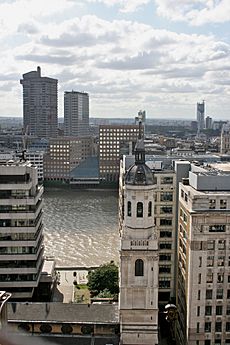
Late 19th and Early 20th Centuries
In the late 19th century, the rectors included Alexander McCaul, who was a missionary to Polish Jews and a professor at King's College London. His daughter, Elizabeth Anne Finn, was a noted linguist and founded several organizations.
In 1890, there was talk of combining St Magnus with another church, St George Botolph Lane, and demolishing St George's. Although services stopped there, St George's wasn't demolished until 1904.
Until 1922, the annual Fish Harvest Festival was held at St Magnus, showing its close ties to the local fish market. The church was once "buried in the stink of Billingsgate fish-market."
In 1920, a committee suggested demolishing 19 City churches, including St Magnus. There was a huge public outcry. T. S. Eliot wrote about how important these churches were to London's beauty. The London County Council said St Magnus was "one of the most beautiful of all Wren's works" and should not be demolished. Because of this uncertainty, the church's leadership was temporarily put on hold. However, in 1921, the Revd Henry Joy Fynes-Clinton became the new rector, which meant the demolition plan would not go ahead.
Between the Wars: Father Fynes-Clinton
The inside of the church was restored in 1924 by Martin Travers in a neo-baroque style. This reflected the Anglo-Catholic (a branch of the Church of England that keeps many traditional Catholic practices) nature of the church under Henry Joy Fynes-Clinton, who was rector from 1921 until his death in 1959. He made the church's interior very beautiful.
Fynes-Clinton was known for his strong Anglo-Catholic beliefs. He often held services in Latin. In 1922, he restarted the Fraternity of Our Lady de Salve Regina, an old religious group. He also put up a statue of Our Lady of Walsingham and organized pilgrimages to the shrine in Norfolk.
In 1937, Father Fynes-Clinton visited Kirkwall for the 800th anniversary of St Magnus Cathedral. He also went to Egilsay, where St Magnus was killed. He suggested building a stone memorial there, which was completed in 1938. It stands 12 feet high and has an inscription from both the London and Kirkwall churches.
World War II to Today
During the Blitz in World War II, a bomb hit London Bridge in 1940, blowing out all the church windows and damaging the roof. However, the church was repaired and reopened in 1951. It was designated a Grade I listed building in 1950.

Father Fynes-Clinton was followed by Father Colin Gill in 1960, who was also closely connected with the Walsingham shrine. In 1971 and 1994, there were more proposals to change the City churches, but these were stopped after public protests.
Since 2003, the parish priest has been Father Philip Warner. Since 2004, there has been an annual Blessing of the Thames, where the congregations of St Magnus and Southwark Cathedral meet on London Bridge. In 2016, a relic of St Thomas Becket was brought to St Magnus for people to see and honor.
The church has a high standard of music. The choir has released CDs, and the organist and other musicians have won awards for their compositions. St Magnus is also used for various musical events and has been featured on TV shows.
Inside the Church
Martin Travers restored the main altar in 1924, adding paintings of Moses and Aaron and the Ten Commandments. Above the altar, he added a painted and gilded rood (a cross with figures). A new altar was installed, and the communion rails were moved to make the sanctuary bigger. Two old door frames were used to create side chapels.
The interior was made to look more European by replacing the old box pews with new ones. The pulpit was also updated. Travers designed the statues of St Magnus of Orkney and Our Lady of Walsingham.
On the north wall, there is a Russian Orthodox icon painted in 1908. The modern stations of the cross are made of Japanese oak. One window on the north wall is from 1671 and came from Plumbers' Hall. Other windows show the coats of arms of various London companies.
The stained glass windows on the south wall, made by Lawrence Lee between 1949 and 1955, show churches that are no longer standing but were connected to the parish. These include the ruined church of St Magnus on Egilsay, the lost church of St Margaret in New Fish Street, the lost church of St Michael in Crooked Lane, and St Thomas Becket's chapel on Old London Bridge.
The church has a detailed model of Old London Bridge. One tiny figure on the bridge looks like a policeman, representing the model-maker, David T. Aggett, who was a police officer.
The church also owns two old fire engines from the parish of St Michael, Crooked Lane. One is on display inside the church.
Bells
Before the Great Fire of 1666, the old tower had five bells. After the fire, new bells were cast, but the tower wasn't ready. A new tower was finished in 1704, and the bells were moved there.
In 1714, the number of bells was increased to ten. The bells were cast by Richard Phelps. The second bell had to be recast in 1748, and the largest bell was recast in 1831, just in time to ring for the opening of the new London Bridge.
In 1940, during World War II, the 10 bells were removed for safety and stored in the churchyard. In 1951, it was found that four of them were cracked. After a long time, the bells were sold for scrap in 1976. The metal was used to cast many of the "Bells of Congress" in Washington, D.C.
A new fund was started in 2005 to install a new set of 12 bells. The money was raised, and the bells were cast in 2008-2009. They were blessed by the Bishop of London on March 3, 2009. The bells are named after saints, including Michael, Margaret, Thomas of Canterbury, and Magnus.
The first full peal (a long sequence of bell changes) on the new 12 bells was rung on November 29, 2009. The bells have been rung for many important events, including the Thames Diamond Jubilee Pageant in 2012 and during the Olympic/Paralympic marathons. In 2021, the tenor bell was tolled 99 times after the death of Prince Philip, Duke of Edinburgh.
The BBC television program Still Ringing After All These Years: A Short History of Bells featured an interview at St Magnus with the Tower Keeper, Dickon Love, who taught John Barrowman how to ring a bell for the BBC coverage. The bells are often rung on Sundays by the Guild of St Magnus.
Connections to London Groups
St Magnus has strong ties to three important London groups called livery companies. Their coats of arms are shown in the church's stained glass windows. Every other June, the newly elected leaders of the Fishmongers' Company walk from their hall to St Magnus for a special service.
St Magnus is also the official church for The Plumbers' Company. Two former rectors of St Magnus have even served as the Master of the Plumbers' Company. The Coopers' Company also holds an annual service at the church.
St Magnus is also the church for the Ward of Bridge and Bridge Without, which is an area of the City of London. The Bridge Ward Club, founded in 1930, holds its annual carol service at St Magnus.
See also


